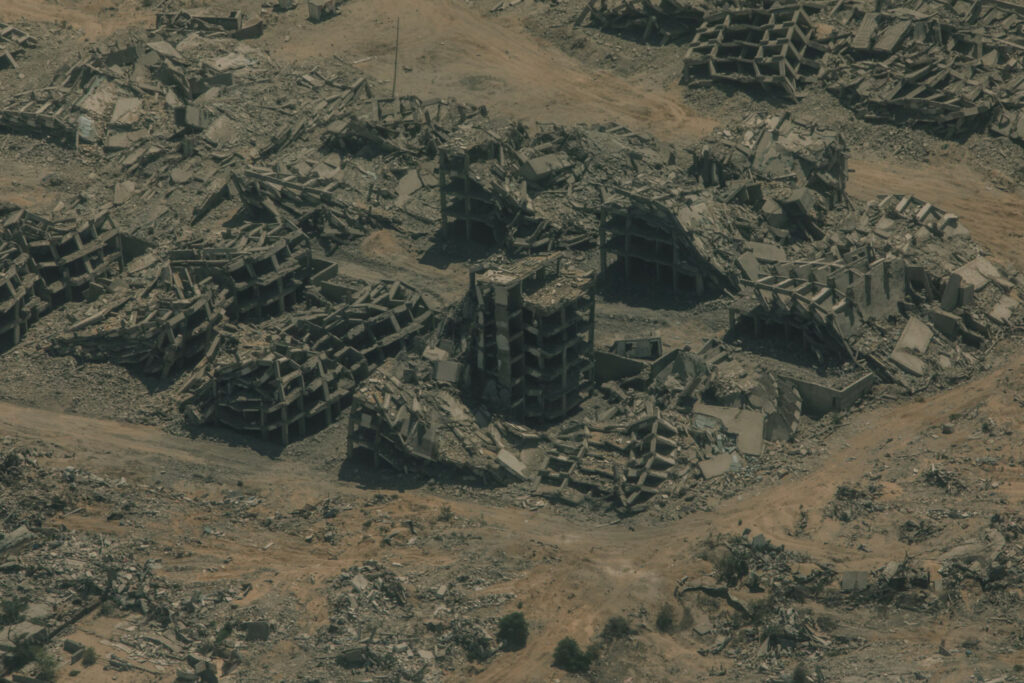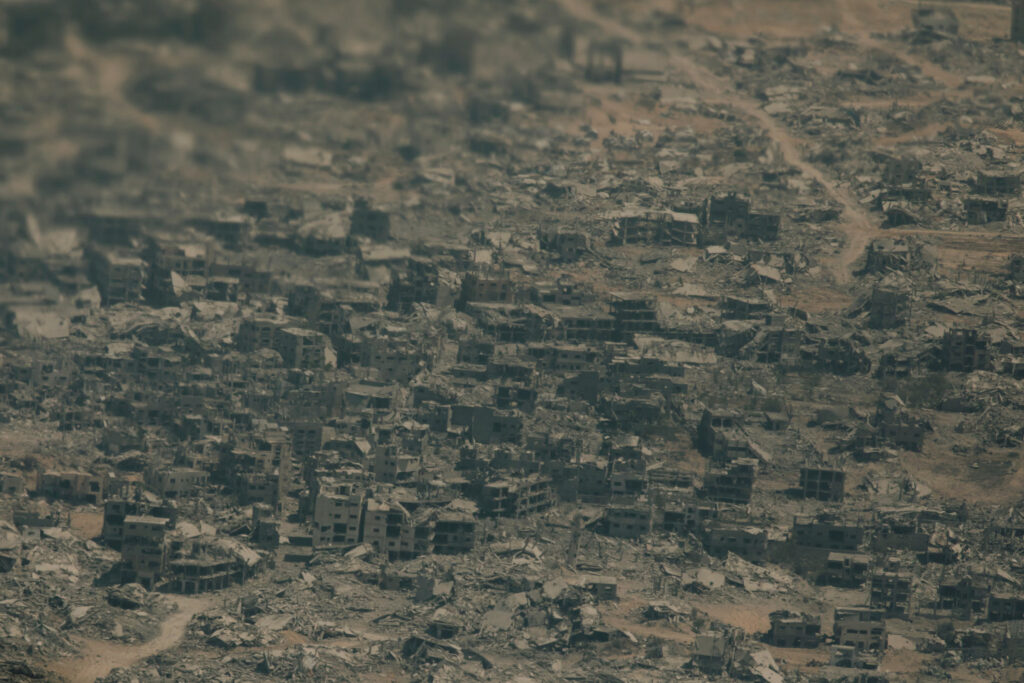A Wasteland of Rubble, Dust and Graves: How Gaza Looks from the Sky
IN FOCUS, 11 Aug 2025
Lorenzo Tondo | The Guardian - TRANSCEND Media Service
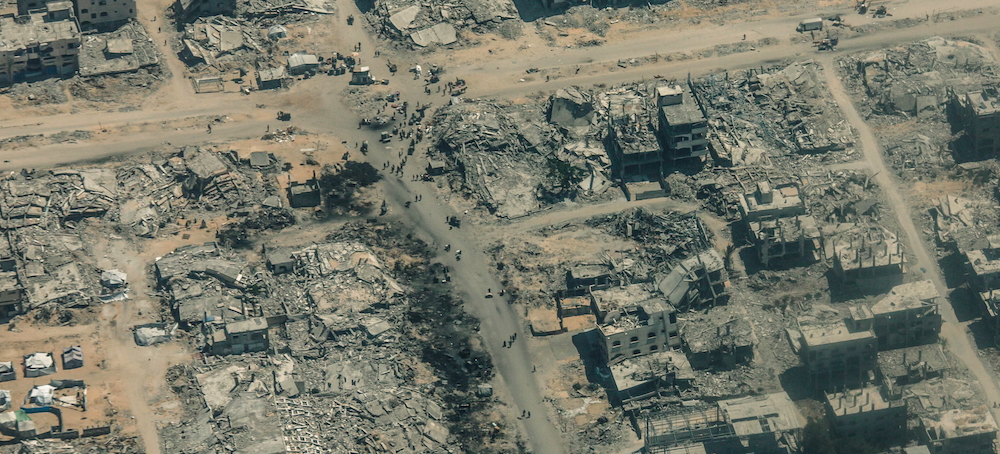
People can be seen gathering around the rubble of a suburb in the central Gaza Strip.
(photo: Alessio Mamo/Guardian UK)
The Guardian joins a Jordanian military airdrop for a rare chance to observe a landscape devastated by Israel’s genocidal destruction of Gaza.
5 Aug 2025 – Seen from the air, Gaza looks like the ruins of an ancient civilisation, brought to light after centuries of darkness. A patchwork of concrete shapes and shattered walls, neighbourhoods scattered with craters, rubble and roads that lead nowhere. The remnants of cities wiped out.
But here, there has been no natural disaster and no slow passage of time.
Gaza was a bustling, living place until less than two years ago, for all the challenges its residents endured even then. Its markets were crowded, its streets were full of children. That Gaza is gone – not buried under volcanic ash, not erased by history, but razed by an Israeli military campaign that has left behind a place that looks like the aftermath of an apocalypse.
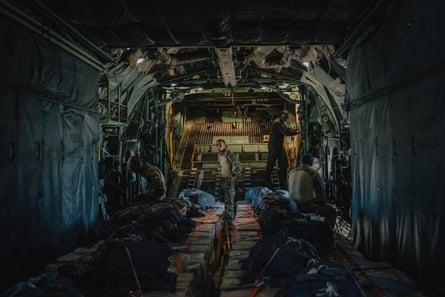
Members of Jordan’s military stand among pallets of aid about to be dropped on Gaza
The Guardian was granted permission on Tuesday to travel onboard a Jordanian military aircraft providing aid. Israel announced last week that it had resumed coordinated humanitarian airdrops over Gaza, following mounting international pressure over severe shortages of food and medical supplies, which has reached such a crisis point that a famine is now unfolding there.
The flight offered not only a chance to witness three tonnes of aid – far from sufficient – dropped over the famine-stricken strip but also a rare opportunity to observe, albeit from above, a territory that has been largely sealed off from the international media since 7 October and the subsequent offensive launched by Israel. Following the Hamas-led attacks that day, Israel barred foreign journalists from entering Gaza – an unprecedented move in the history of modern conflict, marking one of the rare moments that reporters have been denied access to an active war zone.
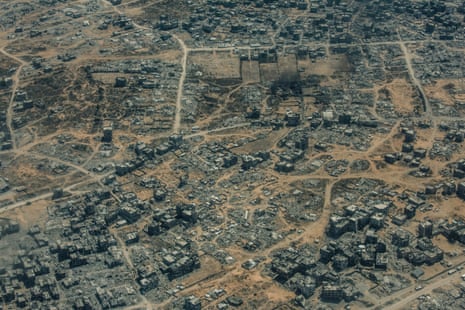
Even from an altitude of about 2,000ft (600 metres), it was possible to glimpse places that mark some of the conflict’s most devastating chapters – a landscape etched with the scars of its deadliest attacks.
These are the sites of bombings and sieges that have been courageously documented by Palestinian journalists – often at the cost of their own lives. More than 230 Palestinian reporters lie buried beneath in hastily dug cemeteries.
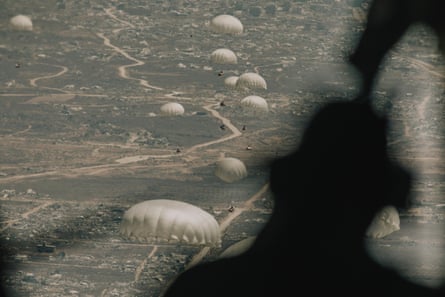
Airdrops released from the plane
About an hour and a half after takeoff, the plane flies over the ruins of northern Gaza and Gaza City, now a wasteland of crumbling concrete and dust. Buildings are reduced to rubble, roadways pitted with craters, entire neighbourhoods flattened. From this distance it is nearly impossible to see Gaza’s inhabitants. Only through a nearly-400mm camera lens is it possible to make out a small group of people standing among the ruins of a shattered landscape – the only sign of life in a place that appears otherwise uninhabitable.
As the aircraft approaches the Nuseirat refugee camp, the rear hatch opens and pallets of aid slide out, parachutes blooming behind as they fall toward the ground.
“With today’s airdrops, the Jordan Armed Forces-Arab Army has now conducted 140 airdrop operations, in addition to 293 in cooperation with other countries, delivering 325 tonnes of aid to Gaza since the resumption of airdrops on 27 July,” a note from the Jordanian military reads.
Yet such quantities are nowhere close to being enough. Humanitarian agencies warn that hunger is spreading rapidly through the territory. While airdrops can create the perception that something is being done, they are, by common consensus, costly, inefficient and do not get anywhere near to the amount of aid that could be delivered by lorries. In the first 21 months of war, 104 days of airdrops supplied the equivalent of just four days of food for Gaza, Israeli data shows.
They can also be deadly; at least 12 people drowned last year trying to recover food that landed in the sea, and at least five were killed when pallets fell on them.
Farther south, the plane passes over Deir al-Balah, in central Gaza. There, in the Baraka area below, on 22 May, 11-year-old Yaqeen Hammad, known as Gaza’s youngest social media influencer, was killed after a series of heavy Israeli airstrikes hit her house while she watered flowers in a tiny patch of greenery eked out of a displacement camp.
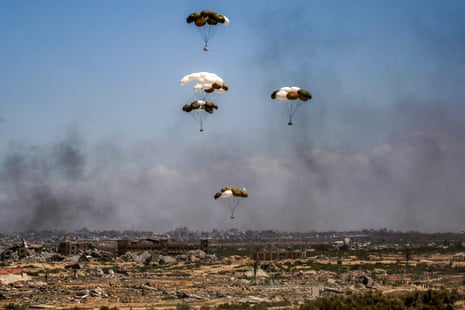
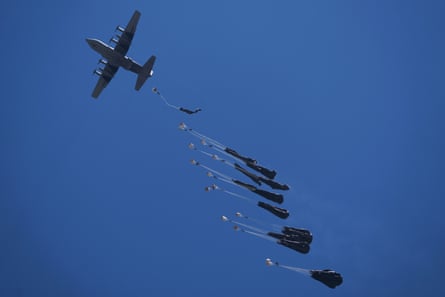
Pallets parachute down after being dropped from a military plane over Nuseirat
A couple of kilometres further, the aircraft flies near Khan Younis, besieged for months by Israeli forces amid fierce fighting in and around its hospitals. Somewhere in the northern suburbs are the remains of the home of Dr Alaa al-Najjar, a Palestinian paediatrician who worked at al-Tahrir hospital, part of the Nasser medical complex. Her house was bombed in May while she was on shift. Her husband and nine of her 10 children were killed in the attack.
From the skies, it is striking just how small Gaza is – a sliver of land that has become the stage for one of the world’s bloodiest conflicts. The territory is more than four times smaller than Greater London. In this tiny corner of the Middle East, more than 60,000 people have been killed in Israeli strikes, according to health authorities. Thousands more are estimated to remain buried under the rubble.
A few hundred metres beneath us, the Guardian reporter Malak A Tantesh, a journalist and a survivor, works on one of her dispatches. Most of her fellow reporters, editors and other colleagues are yet to meet Tantesh, owing to the Israeli blockade that makes it impossible for Gaza’s people to leave. She has been displaced multiple times, lives without reliable access to food or water, and has lost relatives, friends and her home in the fighting. It is a strange and haunting feeling to receive a message from her as the Jordanian aircraft flies above.
As our aircraft turns back toward Jordan, a soldier onboard points toward the hazy horizon to the south. “That’s Rafah down there,” he says.
Gaza’s southernmost area, Rafah is a region now largely destroyed, where hundreds have died in the scramble for food since the Israeli- and US-backed Gaza Humanitarian Foundation took over food deliveries in May. Just a few kilometres to the east, amid crater-pocked hills, lies the site where, on 23 March, an Israeli military unit struck a convoy of Palestinian emergency vehicles, killing 15 medics and rescue workers who were later buried in a mass grave.
After touching down at Jordan’s King Abdullah II airbase in Ghabawi, the same question seems to linger among the handful of reporters who boarded the flight: when will we see Gaza again?
And after seeing this desert of shattered stones and graves, what more can be destroyed when so much has already been lost?
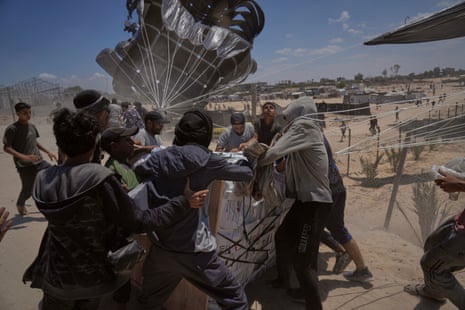
Tags: Anti Zionism, Collective Punishment, Crimes against Humanity, Cultural violence, Direct violence, Ethnic Cleansing, Famine, Gaza, Genocide, Hamas, Hunger, International Court of Justice ICJ, International Holocaust Remembrance Alliance, Israel, Israeli occupation, Military Industrial Technological Complex, Nakba, Palestine, Palestinian Holocaust, Sociocide, State Terrorism, Structural violence, USA, War crimes, West Bank
DISCLAIMER: The statements, views and opinions expressed in pieces republished here are solely those of the authors and do not necessarily represent those of TMS. In accordance with title 17 U.S.C. section 107, this material is distributed without profit to those who have expressed a prior interest in receiving the included information for research and educational purposes. TMS has no affiliation whatsoever with the originator of this article nor is TMS endorsed or sponsored by the originator. “GO TO ORIGINAL” links are provided as a convenience to our readers and allow for verification of authenticity. However, as originating pages are often updated by their originating host sites, the versions posted may not match the versions our readers view when clicking the “GO TO ORIGINAL” links. This site contains copyrighted material the use of which has not always been specifically authorized by the copyright owner. We are making such material available in our efforts to advance understanding of environmental, political, human rights, economic, democracy, scientific, and social justice issues, etc. We believe this constitutes a ‘fair use’ of any such copyrighted material as provided for in section 107 of the US Copyright Law. In accordance with Title 17 U.S.C. Section 107, the material on this site is distributed without profit to those who have expressed a prior interest in receiving the included information for research and educational purposes. For more information go to: http://www.law.cornell.edu/uscode/17/107.shtml. If you wish to use copyrighted material from this site for purposes of your own that go beyond ‘fair use’, you must obtain permission from the copyright owner.
Join the discussion!
We welcome debate and dissent, but personal — ad hominem — attacks (on authors, other users or any individual), abuse and defamatory language will not be tolerated. Nor will we tolerate attempts to deliberately disrupt discussions. We aim to maintain an inviting space to focus on intelligent interactions and debates.
